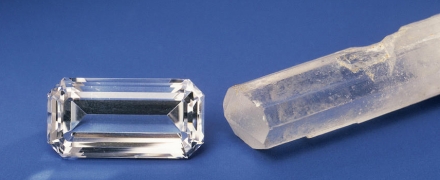open 10 am - 7 pm
laboratory is closed
Zeolites in rings

In gemological practice, stones are often found that are often not associated with precious or jewelry at all. Despite this, they have all the necessary properties to be cut. Most often, these stones include colorless or pale-colored minerals with a hardness of about 5 - 5.5 on the Mohs scale. Such "unlucky" minerals can be safely attributed to zeolites of the mineral series scolecite-natrolite, natrolite itself and scolecite, as well as an intermediate in composition mesolite mineral. Although the cuts of these stones are quite common on mineralogical trading platforms, and natrolite is the most common among the minerals of this series, finding a visually clear cut natrolite over 5 carats in size is not an easy task, and one can only dream of a 10 carat stone. Large crystals of gem-quality natrolite can be found in the central zones of alkaline pegmatites. In hydrothermal veins, jewelry crystals of both natrolite and scolecite grow, sometimes crystals of a transitional composition are found, as well as having a scolecite composition in one part of the crystal, and natrolite in the other. The trouble is that these stones, as a rule, do not correspond to the cutting quality. One and the most important disadvantage of zeolites is that these minerals do not form placers due to their susceptibility to the influence of not only physical factors of weathering, but also to the effects of natural chemical agents - they crack and become cloudy.
В геммологической практике бывают весьма увлекательные случаи с диагностикой ювелирных вставок
Но помимо редкости цвета и высокой стоимости таких камней, многие розовые камни выделяются одной замечательной особенностью – они проявляют плеохроизм, то есть в зависимости от положения осмотра камня он может иметь дополнительные оттенки – оранжевый или пурпурный.
Currently, gemstones are produced by two fundamentally different technological methods - the High Pressure - High Temperature method (“HPHT”, High-pressure & High-temperature) and the Chemical Vapor Deposition (“CVD”, Chemical vapor deposition) method. The "HPHT" method is the most tested classical synthesis method, which can be used both carbon deposition on diamond from flux melts and catalytic reactions. In "CVD" synthesis, diamond growth occurs on a seed during carbon deposition mainly from a gaseous medium at relatively low temperatures and pressures.
Jewelry and precious stones are just such a category of goods, when buying which you need to pay attention to many criteria.
Sogdianite is a rather rare mineral and more often it can be found as a collection material (moreover, in systematic collections), and it is extremely rare in jewelry.






